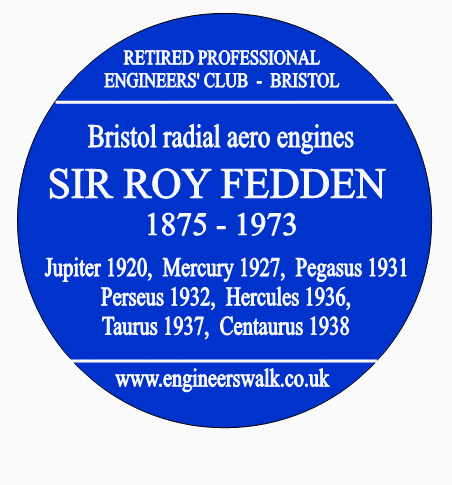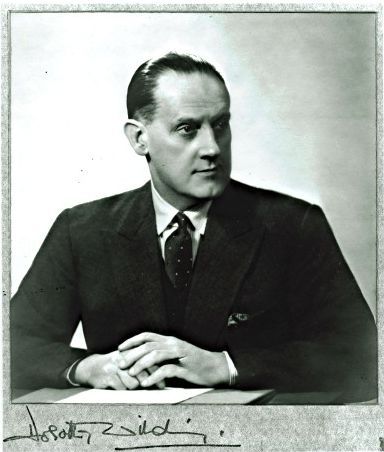 Henry's third son was Albert Hubert Roy Fedden born in 1885. Young Roy enjoyed a happy family life including fishing and sailing with his father. At Clifton College he did not let academic matters interfere with sporting interests including cricket. Fedden fielded at cover point throughout the world record innings by his friend AEJ Collins who scored 628 not out plus or minus 20 in 1899. He also enjoyed assisting the chauffer with his father's troublesome Decauville motor car, only the fourth car registered (AE4) in the Bristol area. When in 1903 Fedden's headmaster suggested he should go into the army, there was consternation when he declared that he wished to become an engineer. Courtship of his sweetheart Norah Crew was now out of the question.
Henry's third son was Albert Hubert Roy Fedden born in 1885. Young Roy enjoyed a happy family life including fishing and sailing with his father. At Clifton College he did not let academic matters interfere with sporting interests including cricket. Fedden fielded at cover point throughout the world record innings by his friend AEJ Collins who scored 628 not out plus or minus 20 in 1899. He also enjoyed assisting the chauffer with his father's troublesome Decauville motor car, only the fourth car registered (AE4) in the Bristol area. When in 1903 Fedden's headmaster suggested he should go into the army, there was consternation when he declared that he wished to become an engineer. Courtship of his sweetheart Norah Crew was now out of the question.
The Motor Car EngineerFedden had a 3 year apprenticeship with Bristol Motor Company in Redcross Street paid for by his father. He learned the basic skills of mechanical engineering in treating metals and cutting them with machine tools and he learned how to inspire working men. He studied automotive engineering at night school, under the highly respected Professor William Morgan at the Merchant Venturerޓs Technical College. Towards the end of 1906 Fedden decided that there was a future for smaller, cheaper, owner driven and maintained cars, so he designed a two seater he named the Shamrock.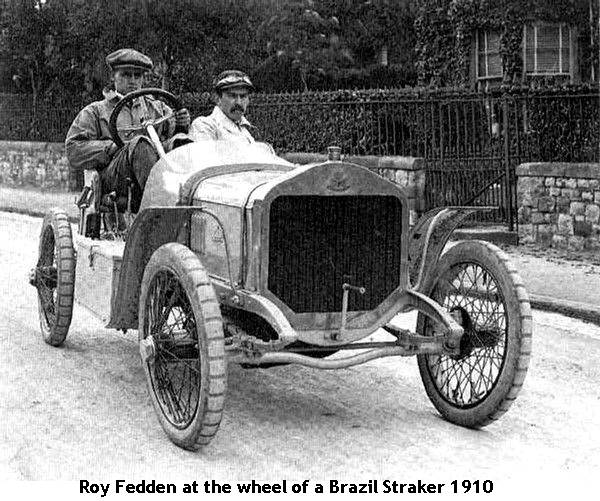 The precocious 21 year old persuaded Mr Brazil of Brazil Straker, manufacturers of various road vehicles, not just to take him on, but to put him in charge of the experienced design team and to build his Shamrock car. One of its novel features was half shafts and differential (components that failed frequently in these early days of motoring) that could be quickly removed from the car without jacking it up. The car was exhibited at Olympia in November 1907 with a price tag of 𧶲, about half the price of similar cars by other manufacturers. Sales of Straker Squire cars rose quickly rose to about 600 cars a year. In 1914 at the age of 29 Fedden was appointed to the Board as Technical Director and too busy to court Norah, so she married somebody else.
The precocious 21 year old persuaded Mr Brazil of Brazil Straker, manufacturers of various road vehicles, not just to take him on, but to put him in charge of the experienced design team and to build his Shamrock car. One of its novel features was half shafts and differential (components that failed frequently in these early days of motoring) that could be quickly removed from the car without jacking it up. The car was exhibited at Olympia in November 1907 with a price tag of 𧶲, about half the price of similar cars by other manufacturers. Sales of Straker Squire cars rose quickly rose to about 600 cars a year. In 1914 at the age of 29 Fedden was appointed to the Board as Technical Director and too busy to court Norah, so she married somebody else.
The Aero EngineerIn May 1914 he visited Bosch in Germany to buy their self starters and headlights. He also visited a Mercedes factory and by chance stumbled into a very large production line for water cooled straight six cylinder aero engines and was greatly impressed. The Royal Naval Air Service (RNAS) was training pilots using an American Curtiss aircraft but the OXLJ engines were proving unreliable and there were a lot of crashes. Fedden was invited to investigate and soon found evidence of poor workmanship and lack of quality control. In a remarkably short time Fedden re-designed the OX-5, and delivered more reliable engines to RNAS. He was assisted by Leonard 'Bunny' Butler, an excellent designer/draughtsman, who worked loyally for Fedden for the rest of his life.The Fishponds factory was requisitioned by the Admiralty and was entrusted to build Rolls-Royce engines, first the Hawk (water cooled straight 6-cylinder) that was used to drive airships, then a vee 12 cylinder version called the Falcon which was used in the famous Bristol Fighter. In addition parts for the Rolls-Royce Eagle engine (water cooled vee 12 cylinder) were manufactured. Rolls-Royce persisted with water cooled engines, of this configuration, providing long slim engines that fitted neatly into a narrow fuselage or engine cell. On the other hand, air cooled radial engines with the cylinders arranged like the spokes of a wheel, offer short stiff crankshafts, and considerably lighter weight as they do not require a water cooling system. Fedden favoured the air cooled radial engine and in 1917 designed the Mercury (300HP) engine with two staggered rows of seven cylinders. Each row had seven connecting rods to one of the pair of crankpins in the crankshaft. Realising that more powerful engines would soon be required he designed the Jupiter a nine cylinder (450 HP) radial engine. The Lucifer (100 HP) was a 3 cylinder lightweight engine using shortened Jupiter cylinders. All three engines types ran well and were test flown in various aircraft, but as the war ended there were no orders. In 1918 Fedden married a divorcee with a son at Clifton College, but the marriage did not turn out well. 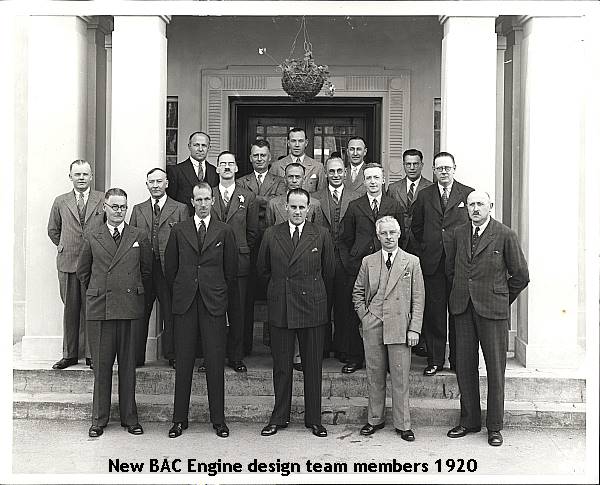 Fedden had started work on new car designs anticipating higher demand after the war but the Fishponds factory was sold to a Finance Group called Cosmos. Perversely Cosmos sold the motor car business but retained the aero engine business, and before long went into liquidation. Fedden was left with three engine types, a reduced design team and a factory which he held on behalf of the receiver. Bristol Aeroplane Company (BAC) bought the lot for just 㾻,000 and their new Engine Department was founded on 29 July 1920. Fedden had started work on new car designs anticipating higher demand after the war but the Fishponds factory was sold to a Finance Group called Cosmos. Perversely Cosmos sold the motor car business but retained the aero engine business, and before long went into liquidation. Fedden was left with three engine types, a reduced design team and a factory which he held on behalf of the receiver. Bristol Aeroplane Company (BAC) bought the lot for just 㾻,000 and their new Engine Department was founded on 29 July 1920. BAC was owned by the White family but none of them were engineers. They knew Fedden was a first rate engineer with a strong will which would have to be controlled, however the Chairman Sir Stanley White was prepared to invest 𧶀,000 in developing the Jupiter. Fedden negotiated a pay structure that included a bonus on every engine of his design sold. When success came he became a wealthy man, probably the highest paid engineer in Europe, but he was never invited to become a Director of the Company. He moved the factory from Fishponds to existing sheds about a mile north of the aircraft works, which were fitted out with services and some high quality machine tools acquired cheaply from another defunct engine factory. The Jupiter Engine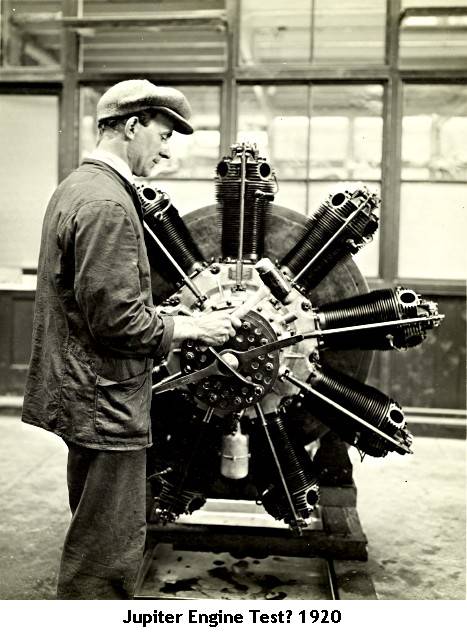 Fedden set about making the Jupiter the best engine in the world using some novel methods to overcome metal fatigue. He engaged Professor Aitchison to install test machines, to suggest design changes which would minimise local stress concentration in components, and to visit materials suppliers with Fedden to demand the highest quality. The valve gear was redesigned to compensate automatically as the engine temperature rose. The modified engine was subjected to the most rigorous testing and passed the new Air Ministry Type Test. The Jupiter was taken to the Paris Air show in 1921 where it was enthusiastically received. The Gnome Rhone Company took a license to manufacture the Jupiter which passed French test requirements with flying colours. In 1923 the RAF placed their first order for 81 Jupiter engines.
Fedden set about making the Jupiter the best engine in the world using some novel methods to overcome metal fatigue. He engaged Professor Aitchison to install test machines, to suggest design changes which would minimise local stress concentration in components, and to visit materials suppliers with Fedden to demand the highest quality. The valve gear was redesigned to compensate automatically as the engine temperature rose. The modified engine was subjected to the most rigorous testing and passed the new Air Ministry Type Test. The Jupiter was taken to the Paris Air show in 1921 where it was enthusiastically received. The Gnome Rhone Company took a license to manufacture the Jupiter which passed French test requirements with flying colours. In 1923 the RAF placed their first order for 81 Jupiter engines.There were other ideas for improving reliability. Instead of allowing customers to install engines themselves, Fedden started an installation department to do the job to his exacting standards. In earlier times failed engines were simply abandoned, but Fedden stripped them down for minute examination to establish the cause of failure. The failed parts were kept in a sort of museum where a greater understanding of types of failure could be gained. In order to assemble the big end of a connecting rod on to a crankshaft, one of the pieces has to be made in two parts. In the early Jupiter, the big end was in two parts, but Fedden changed to a one piece big end which was then assembled on to a two piece crankshaft. Another idea which came from 'Bunny' Butler and Fred Whitehead (Head of Production) was to dismantle six used Jupiters, mix up the parts and reassemble six engines which performed very well proving the quality of the design. By 1926 the Jupiter was the best aero engine in the world and in the 1929 Paris Air show nearly every aircraft on display was powered by the Jupiter engine. By continuous development and extended test running at high powers the engine retained this position until 1932. A new drop forged cylinder head provided better cooling, permitting an increased power rating. There was considerable interest in peripheral devices. A gas driven engine starting system was devised, cowlings were introduced to improve streamlining and improved propellers were investigated. 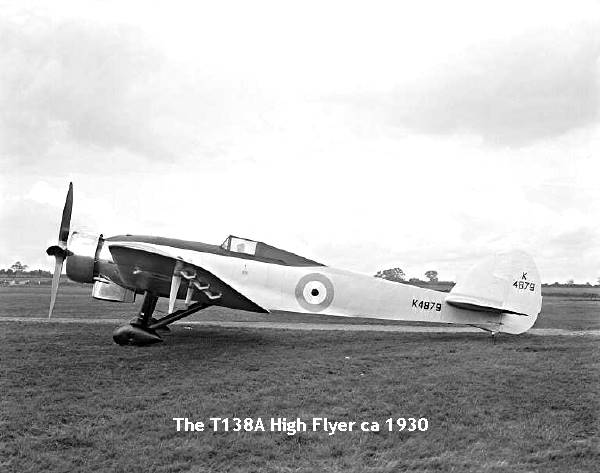 At higher altitudes where the air is thinner, power output is reduced. To compensate, it is necessary to increase the amount of air compressed into the cylinders, which raises the risk at lower altitudes of pre-ignition while the piston is still compressing the fuel/air mix. This is commonly called knocking and can severely damage an engine very quickly. A mechanical supercharger was introduced to increase power at high altitude and later automatic boost control was added to stop the pilot using too much supercharging at low altitude. A high speed turbo charger, to achieve the same end, was found to be practical but was considered too expensive to develop. Other means of reducing knocking were antiknock fuel, and retarded ignition at low altitudes but these were considered too complicated.
At higher altitudes where the air is thinner, power output is reduced. To compensate, it is necessary to increase the amount of air compressed into the cylinders, which raises the risk at lower altitudes of pre-ignition while the piston is still compressing the fuel/air mix. This is commonly called knocking and can severely damage an engine very quickly. A mechanical supercharger was introduced to increase power at high altitude and later automatic boost control was added to stop the pilot using too much supercharging at low altitude. A high speed turbo charger, to achieve the same end, was found to be practical but was considered too expensive to develop. Other means of reducing knocking were antiknock fuel, and retarded ignition at low altitudes but these were considered too complicated.Jupiters powered the RAF fighters of the period, principally the Bristol Bulldog and the Westland Wapiti and the Imperial Airways fleets of Handley Page airliners and Short Bros flying boats. Licences were sold for the manufacture of Jupiters in 17 other countries including USA, Germany, Japan and Russia. One particularly interesting application was the Dornier DoX a 169 seat flying boat which carried 12 Jupiter engines, 6 facing forward (pulling) and 6 facing backwards (pushing). The Mercury and Pegasus EnginesOne recurring criticism of the Jupiter was its large frontal area. As early as 1925 Fedden set about producing a smaller engine by using shorter cylinders and the Mercury name was revived. The new engine was installed in a racing seaplane the Short Bros. Crusader intended as a Schneider Trophy contender. Early trials were encouraging but the engine failed catastrophically and the plane crashed. Re-design of pistons, crank, enclosed valve gear and cooling fins with extensive testing of single cylinders and complete engines produced an engine more powerful than the Jupiter. The new features were applied to the Jupiter resulting in an even more powerful engine which was given the name Pegasus. Both the Pegasus (9 cylinder radial 7.5 inch stroke) and the Mercury (9 cylinder radial 6.5 inch stroke) were launched in 1932, the latter being offered for high speed machines and were both very successful. There was considerable redesign to accommodate 87 octane fuel (earlier fuel was 77 octane) which became available in 1934.There were other experimental engines which were not developed commercially 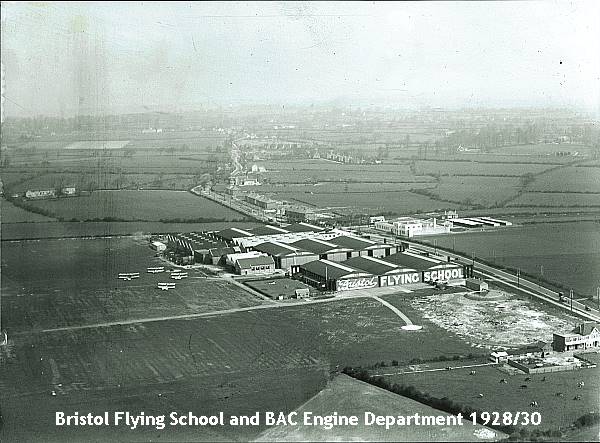 Orion 1928 - Jupiter with turbocharger
Titan 1928 - 5 Mercury sized cylinders
Phoenix 1932 - A diesel fuelled Pegasus
Draco 1932 - A Pegasus with fuel injection
Hydra 1934 - 16 cylinders in 2 rows with 5 inch stroke
Orion 1928 - Jupiter with turbocharger
Titan 1928 - 5 Mercury sized cylinders
Phoenix 1932 - A diesel fuelled Pegasus
Draco 1932 - A Pegasus with fuel injection
Hydra 1934 - 16 cylinders in 2 rows with 5 inch stroke
This frenetic activity was taking its toll on Fedden's marriage. His wife eventually left, leaving Fedden to support her son and Fedden started seeing his teenage sweetheart Norah Crew whose own marriage had failed. Even his time away from work, fishing, sailing and power boat racing was taken very seriously and usually a business opportunity. Fedden pressed on with new designs. The Hercules had 14 Perseus sized cylinders arrange in two staggered rows. The Taurus had two rows of 7 cylinders with a shorter stroke. Then in 1938 High Duty Alloys came up with an alloy from which cylinders with a low coefficient of expansion could be forged. Firth-Cleveland formulated steel from which the sleeves could be centrifugally cast, and Fred Whitehead worked out how to grind the castings into perfect cylindrical sleeves. Sleeve Valve Engines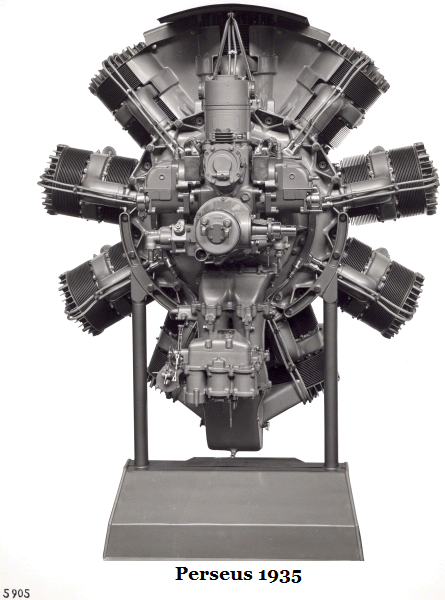 In a four stroke cycle with poppet valves, the inlet valve has to be forced open against a strong spring while the fuel/air mix charges the cylinder pressing the piston down. The valve is then allowed to close and must provide a tight seal while the piston rises again compressing the charge. The charge is then ignited and the expanding gases force the piston down again (this is the power stroke). Finally the exhaust valve must be opened against its spring so that the rising piston can drive out the exhaust gases. The exhaust valve must then be allowed to close tightly for the next cycle to begin. Poppet valve gear is complicated, has to be very strong and very heat resistant.
In a four stroke cycle with poppet valves, the inlet valve has to be forced open against a strong spring while the fuel/air mix charges the cylinder pressing the piston down. The valve is then allowed to close and must provide a tight seal while the piston rises again compressing the charge. The charge is then ignited and the expanding gases force the piston down again (this is the power stroke). Finally the exhaust valve must be opened against its spring so that the rising piston can drive out the exhaust gases. The exhaust valve must then be allowed to close tightly for the next cycle to begin. Poppet valve gear is complicated, has to be very strong and very heat resistant.With the possibility of another war Fedden saw the need for more powerful engines which meant engines with a second row of cylinders. Fedden favoured two inlet and two outlet valves per cylinder. The Hydra had shown that there were great difficulties in designing poppet valve gear for an engine with 64 valves. Fedden didn-t invent sleeve valves which promised a solution but he did face the inherent difficulties and eventually succeeded brilliantly. The sleeve is a thin walled tube that sits inside the cylinder and can move up and down and rotate. A gear train drives the movement of the sleeve so that holes in the sleeve coincide with the cylinder inlet and outlet valves at appropriate times. The piston moves up and down within the sleeve. Clearly the sleeve must be very hard to avoid wear in operation, and must be able to withstand high temperatures. It must have a very similar temperature coefficient of expansion to both the piston and the cylinder to avoid seizure with one or other. 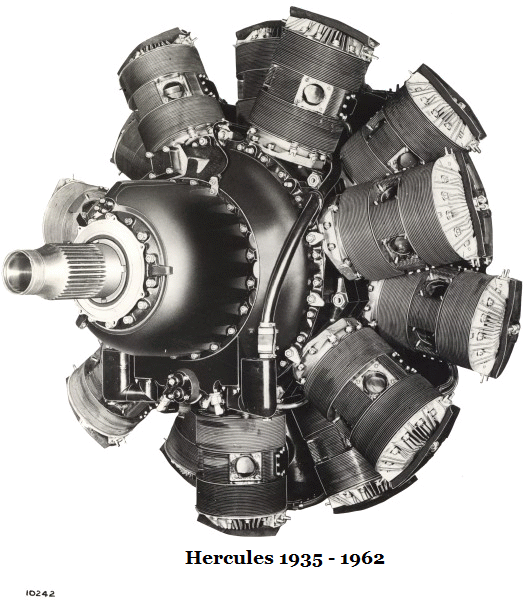 With war imminent the RAF was being rapidly re-equipped and Perseus, Hercules and Taurus sleeve valve engines were ordered for the majority of the new planes. The challenge now was to increase production. But Fedden and Butler still managed to design the Centaurus which had 18 cylinders in 2 rows with a stroke of 7 inches which from the start produced over 2000 hp. The engine was designated for use in fighters, bombers and flying boats.
With war imminent the RAF was being rapidly re-equipped and Perseus, Hercules and Taurus sleeve valve engines were ordered for the majority of the new planes. The challenge now was to increase production. But Fedden and Butler still managed to design the Centaurus which had 18 cylinders in 2 rows with a stroke of 7 inches which from the start produced over 2000 hp. The engine was designated for use in fighters, bombers and flying boats.Fedden had always cultivated contacts with American and German Companies. In 1937/38 he visited Germany three times and Bruno Bruckmann of BMW told him in 1938 that they would not acquire a licence for the Hercules motor because their own engine would be as good and they were developing a gas turbine engine. Fedden's reports back to the British Government were met with skepticism. In August 1939 with war just weeks away he wrote to the Board of BAC that as the engine side of the company was much bigger than the aircraft side, perhaps the company should be reorganised. The Board did not take kindly to this suggestion and never replied. Fedden had never received his bonus on sleeve valve engines and eventually the bonus was stopped altogether. Many tests were conducted on inverted V and straight engines but results were disappointing and Fedden reverted to radial engine with 9 Mercury sized cylinders which took the name Perseus in 1932. The combined sliding and rotation ensured good lubrication within the cylinder and the engine ran very smoothly. It produced even more power with the newly available 100 octane fuel. There was a serious drawback in that the sleeves could not be mass produced accurately to match with any piston or cylinder. In effect each engine was hand built which would not facilitate mass production in wartime. However the Perseus was tested in an Imperial Airways Syrinx and first carried passengers in 1935. Although Rolls-Royce engines were fitted to the 'racehorses' of the air, Fedden's sleeve valve engines were specified for 28 other types of aircraft. Production was all important and the Board encouraged Norman Rowbotham to assume control. Development of the Centaurus was delayed, and there were quality compromises. There were bombing raids on the factory, shadow factories to manage and safer premises to be found for the design team. There were shortages of trained engineers (Fedden had campaigned for better training for years) and difficulties in obtaining bearings from Sweden and other components from USA. Fedden started two more designs with the ever faithful Butler, the Orion like the Centaurus, but with larger cylinders and the Theseus propeller-turbine. In 1942 Roy Fedden was knighted and later that year he was sacked. In November Flight Magazine reported 'The circumstances under which Sir Roy Fedden, for so many years Chief Engineer of the Bristol Aeroplane Co. and responsible for the development of their highly successful aircraft engines, was discharged by the company, were, discussed in considerable detail recently in the House of Lords'. Rowbotham was appointed Chief Engineer and made a Director of the Company. Soon Butler was dead from a heart attack and other members of the design team drifted away. Little was done to develop the engines for civil use after the war. The great days of Bristol Engines were over. Later YearsFedden was happily married to Norah Crew. Their home at Widegates in Westbury on Trym had been destroyed by bombs but they had another comfortable home, Buckland Old Mill beside the River Usk in Breconshire. However Fedden was too young to retire and he chose to take up a post as Special Technical Advisor to the Minister (STAM), the minister in question being Sir Stafford Cripps. There was an extended visit to the USA to study the latest design production methods. This was published to leading manufacturers in the UK but very few of the recommendations were taken up. He also prepared reports on the Royal Navy Torpedo Factory and on Naval Motor Boats. One boat was fitted with four Mercury engines, proving very fast and exceedingly noisy. There were missions to Italy and Germany at the end of the war. Fedden saw many of the ideas that were being developed including gas turbine engines and swept wings, but there was little interest back in the UK.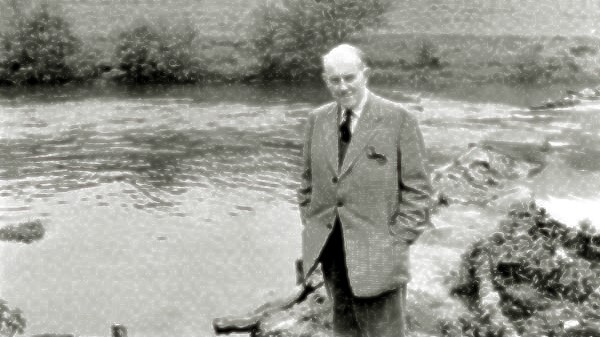 He played an important part in the establishment of Cranfield College of Aeronautics. He played an important part in the establishment of Cranfield College of Aeronautics.At the age of 60 in 1945 he took control of his own company Roy Fedden Ltd to design and build cars and later small gas turbine engines but these ventures were not very successful. There were spells of work for Henry Spurrier at Leyland Motors and George Dowty at Dowty Group. In his last years Sir Roy Fedden had happy times at Buckland Old Mill and died in 1973. John Coneybeare January 2011 Bibliography By Jupiter - The Life of Roy Fedden - Bill Gunston (Royal Aeronautic Society) Fedden - The Life of Roy Fedden - Bill Gunston (Rolls-Royce Heritage Trust) Bristol Aircraft - A Pictorial History of British Achievement - Sir Robert Wall (Halsgrove) |
